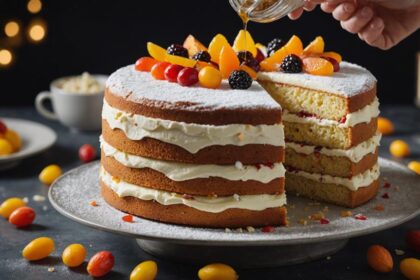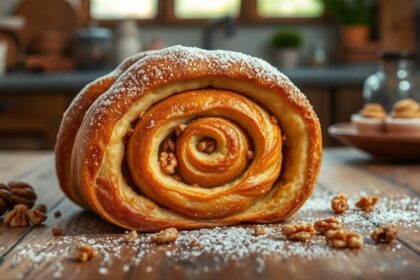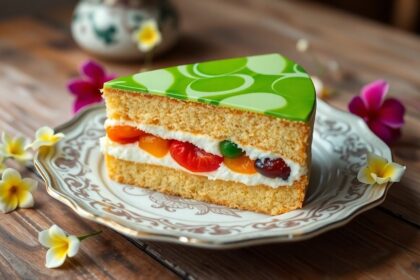Kolaches are unique pastries that originated in the Czech Republic, bringing a rich history to the table. These delightful treats, typically filled with sweet fruits like apricot and cherry or savory ingredients like sausage, are now popular in Texas, thanks to Czech immigrants. You'll appreciate their cultural significance, often seen at family gatherings and festivals celebrating traditions. The dough is soft and comforting, making each bite a blissful experience. As you explore further, you'll discover the various fillings, baking techniques, and community events that enrich this beloved pastry's heritage and flavor.
History of Kolaches
Kolaches have a rich history that dates back to Central Europe, particularly the Czech Republic, where their name comes from the word "koláč," meaning "cake."
When Czech immigrants brought these delightful pastries to the United States in the 1840s, they settled mainly in Texas, making kolaches a beloved part of local cuisine. Traditional kolaches often feature a sweet dough filled with fruits, poppy seeds, or cream cheese, showcasing the cultural significance of these pastries in celebrations. These pastries are reminiscent of other festive breads like Julekage bread, which also symbolize warmth and togetherness during holiday gatherings.
Traditionally, you'd find kolaches at special occasions, symbolizing Czech heritage and community hospitality.
Over the years, these pastries evolved, incorporating local ingredients and flavors, resulting in a variety of sweet and savory fillings. Festivals like the Burleson County Kolache Festival celebrate this unique pastry, showcasing its importance in connecting people and preserving cultural identity.
Each bite reflects the rich history and traditions of Czech immigrants in America. Additionally, the preparation of kolaches often involves a dough consistency that is crucial for achieving the perfect texture and flavor.
Cultural Importance in Texas
For many Texans, kolaches represent more than just a delicious pastry; they embody a rich cultural heritage that connects generations.
Brought to Texas by Czech immigrants in the 1800s, these Czech pastries have become a symbol of community bonding. You'll find them at family gatherings and community events, where they're often served as comfort food. The process of making kolaches is similar to that of creating gluten-free cookies, highlighting the importance of traditional baking techniques. Additionally, the enduring appeal of these recipes reflects their cultural significance, serving as edible works of art and history that remind us of tradition and love.
Festivals like West Fest and the Burleson County Kolache Festival celebrate this beloved treat, showcasing its significance in preserving Czech traditions.
As you enjoy a kolache, you might also notice the evolution of the kolache recipe, incorporating local flavors like jalapeño and cheese. This fusion highlights the contributions of Czech immigrants to Texas's culinary scene and showcases the state's vibrant cultural tapestry. Additionally, the experience of enjoying these pastries often evokes nostalgic memories that connect people to their heritage and family traditions.
Traditional Ingredients Used
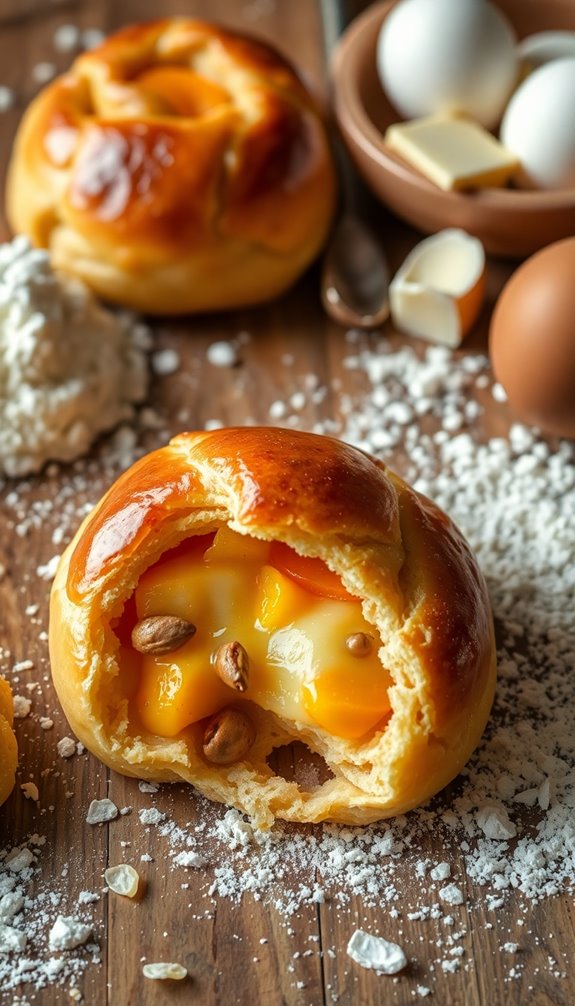
The heart of a kolache lies in its traditional ingredients, which create the perfect balance of flavor and texture.
The dough typically consists of 3.5 to 4 cups of all-purpose flour, providing the necessary structure. Adding about 1 cup of whole milk activates the yeast, ensuring a fluffy outcome. You'll also need 10 tablespoons of butter for rich flavor and moisture, along with 1 large egg and 2 yolks for binding and color enhancement. Gluten-free alternatives like almond flour can be used for those with dietary restrictions, making the kolache accessible for guests with allergies.
When it comes to fillings, sweet cheese mixtures and fruit fillings like apricot or cherry shine, but savory options also exist. The addition of nutty undertones from ingredients like almond extract can elevate the overall flavor profile.
Finally, a touch of granulated sugar in the dough enhances sweetness, making each bite a delightful experience. Enjoy your kolache adventure!
Sweet Fillings and Variations
With the foundation of traditional ingredients set, it's time to explore the delightful world of sweet fillings and variations that make kolaches truly special.
You'll find classic sweet fillings like apricot, cherry, and poppy seeds that reflect Czech heritage, each offering a unique burst of flavor. These fillings are reminiscent of the traditional ingredients found in various baked goods, such as raisins, candied peel, and cardamom, which enhance the flavor profile. Additionally, these sweet fillings can reflect the historical significance of the ingredients used in traditional pastries, showcasing their rich cultural backgrounds.
Modern bakers have taken these pastries to new heights with innovative options like cream cheese and blueberry, perfect for those seeking something different. This creativity parallels the customization seen in traditional holiday treats like Julekake.
Seasonal favorites like pumpkin or pecan add a festive twist.
Many bakeries even change their specialty flavors weekly, inviting you to taste something new each time. This adaptability keeps kolaches exciting, appealing to adventurous eaters who crave both traditional and inventive sweet fillings. Additionally, much like tiramisu's global influence, the versatility of kolaches allows them to be embraced by diverse culinary cultures.
Savory Kolache Options
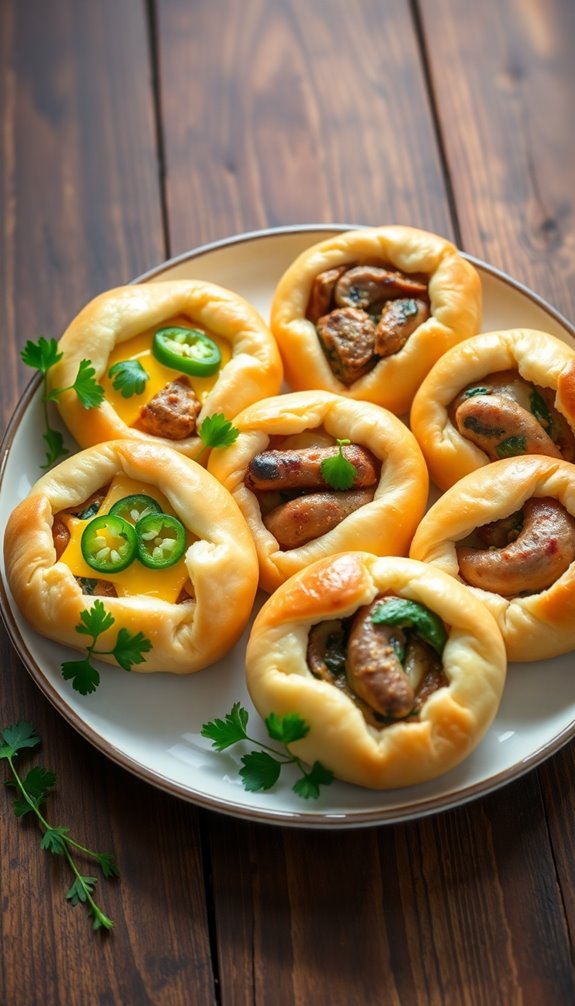
When it comes to savory kolaches, you'll find a mouthwatering array of fillings like sausage and cheese or jalapeños that reflect Texas's regional tastes. These options have become just as popular as sweet ones, making kolaches a great choice for breakfast or a snack. The blend of flavors in these pastries showcases the influence of regional pie styles that highlight local ingredients and culinary creativity. With unique combinations popping up in bakeries, there's never been a better time to explore the savory side of this delicious pastry. Additionally, savory kolaches can be a great option for diabetics looking to enjoy flavorful snacks without the added sugars found in some pastries. The versatility of kolaches allows for endless filling combinations that can cater to various dietary preferences and enhance your culinary experience.
Popular Savory Fillings
Kolaches offer a delightful array of savory fillings that cater to diverse tastes and preferences.
If you love hearty flavors, you can't go wrong with savory kolaches featuring sausage and cheese, a perfect blend of traditional Czech and Texan culinary influences.
For those who crave a kick, jalapeño and cheese kolaches deliver a spicy heat paired with creamy goodness.
Meat lovers will enjoy brisket-filled options that highlight Texas barbecue traditions.
If you're seeking a vegetarian alternative, spinach and feta kolaches provide rich flavor without compromising on taste.
These savory kolaches have become increasingly popular at breakfast and brunch, making them a delicious way to start your day.
Regional Variations Available
Savory kolaches aren't just limited to the classic fillings; they reflect the rich tapestry of regional flavors found across the country.
You'll find savory kolaches showcasing a blend of traditional Czech flavors with local twists. In Texas, for instance, fillings like sausage and cheese or jalapeños highlight regional ingredients, while barbecue brisket adds a bold flair.
Breakfast kolaches filled with bacon, egg, and cheese cater to those seeking a quick, hearty meal on the go. Meanwhile, vegetarian options such as potato and cheese or mushrooms appeal to diverse tastes.
These variations not only celebrate local culinary influences but also have gained popularity at events and festivals, with vendors often selling out these delicious, satisfying treats.
Popular Bakeries in Texas
When you think of kolaches in Texas, you can't overlook the bakeries that have made a name for themselves.
From the classic offerings at Czech Stop to the innovative twists at Batch Craft Beer & Kolaches, there's something for everyone.
Each bakery brings its unique flair, making the kolache experience truly special in the Lone Star State.
Renowned Texas Bakeries
Have you ever wondered where to find the best kolaches in Texas? You're in luck! Here are some renowned bakeries you can't miss:
- Czech Stop in West: Authentic traditional flavors that attract locals and visitors alike.
- Old Main Street Bakery in Rosenberg: A local favorite for both sweet and savory options.
- Hruskas in Ellinger: Classic kolaches made from authentic Czech recipes.
These bakeries showcase the rich heritage of this sweet Czech pastry, perfect for breakfast or a snack.
If you're feeling adventurous, you can even try to make a kolache at home using simple ingredients and baking sheets!
Each bite reflects the cultural significance and deliciousness that kolaches bring to Texas.
Unique Flavor Offerings
Exploring the unique flavor offerings of kolaches in Texas reveals a delightful mix of traditional and inventive fillings that cater to all tastes.
At Czech Stop in West, you can savor authentic kolache dough with sweet fruit fillings like apricot and cherry.
Old Main Street Bakery in Rosenberg presents a variety of sweet and savory options, reflecting local flavors.
Meanwhile, Hruskas in Ellinger maintains Czech heritage while offering a wide selection of fillings.
If you're feeling adventurous, Batch Craft Beer & Kolaches in Austin tempts you with unique flavor combinations like peanut butter and jelly.
Plus, many local coffee shops and grocery stores across Texas contribute to the kolache craze, ensuring these delicious pastries are never far away.
Regional Kolache Trends
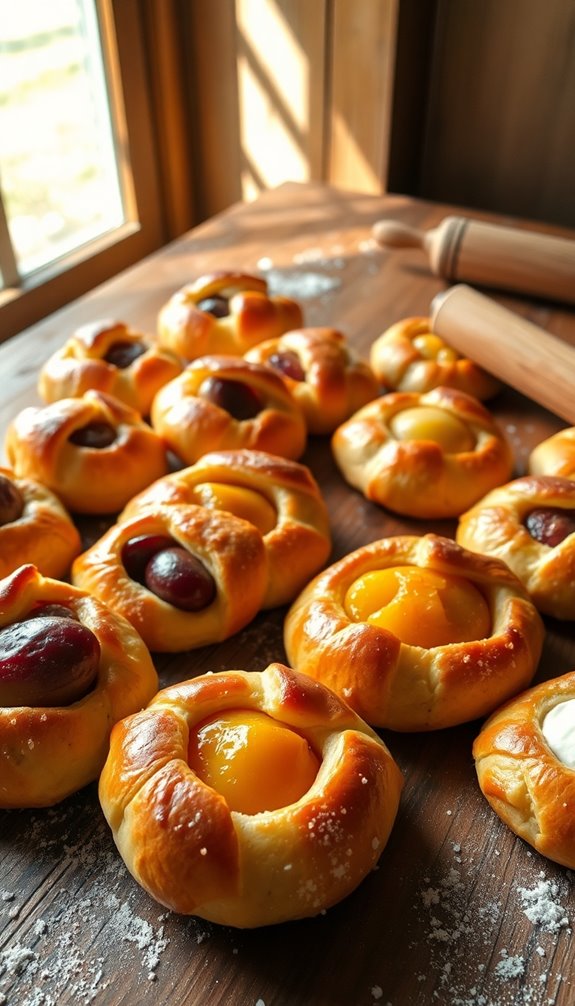
As kolaches gain popularity across the United States, regional trends are shaping the way this beloved Czech pastry is enjoyed.
- In Texas, the kolache capital, you'll find unique flavors like sausage and jalapeño.
- Minnesota's Montgomery celebrates its own variations, highlighting fresh fruit fillings.
- Emerging bakeries in Colorado and Kansas are crafting new takes on this traditional treat.
The evolution of kolaches reflects the rich heritage of Czech immigrants, who began baking these pastries with sugar and fruit.
As local ingredients are incorporated, you'll see a delightful fusion of tastes and styles.
Whether at a festival or a neighborhood bakery, each region puts its spin on this cherished pastry, making every bite a tribute to cultural diversity.
Making Kolaches at Home
Making kolaches at home is easier than you might think!
You'll need some essential ingredients and a straightforward preparation guide to get started.
With a few tips for successful baking, you can enjoy these delicious treats fresh from your oven.
Essential Ingredients Required
To create delicious kolaches at home, you'll need a handful of essential ingredients that come together to form the perfect dough. Here's what you should gather:
- 3.5 to 4 cups of all-purpose flour
- 1 cup of warm milk to activate the yeast
- 10 tablespoons of butter for richness
For the kolache dough, you'll also need 1/3 cup plus 1 teaspoon of sugar, 1 large egg, and 2 egg yolks.
Instant yeast provides quick leavening for that fluffy texture, while salt balances sweetness.
When it comes to fillings, think fruit preserves, sweet cheese, or savory options like sausage and jalapeño.
These ingredients set the stage for a delightful kolache experience that's hard to resist!
Step-by-Step Preparation Guide
Creating kolaches at home is easier than you might think, and it all starts with preparing the dough.
First, activate 1 packet of instant yeast in 1 cup of warm milk mixed with 1/3 cup of sugar until it's foamy.
Combine this mixture with 3.5 to 4 cups of all-purpose flour, 1/4 cup of melted butter, and 2 beaten eggs.
Knead the pastry dough until smooth, then let rise in warm for 1-2 hours until it doubles in size.
After the first rise, roll out the dough, cut it into pieces, and make indentations for your fillings, like fruit preserves or cheese.
Let the filled kolaches rise for another 15 minutes before baking them at 375°F for 12-15 minutes.
Enjoy!
#
Tips for Successful Baking
Once you've mastered the dough preparation, a few tips can help guarantee your kolaches turn out perfectly.
- Verify your yeast is active by dissolving it in warm milk (about 110°F) with a little sugar.
- Knead the dough for 10-15 minutes until it's smooth and elastic.
- Always preheat the oven to 375°F before baking.
After kneading, let the dough rise in a warm area for 1-2 hours until it doubles in size.
Once filled, allow the shaped kolaches to rise for another 15 minutes before placing them in the preheated oven.
Bake for 12-15 minutes until they reach a golden color.
Store any leftovers in an airtight container for up to 2-3 days, or freeze for longer storage.
Dough Preparation Techniques
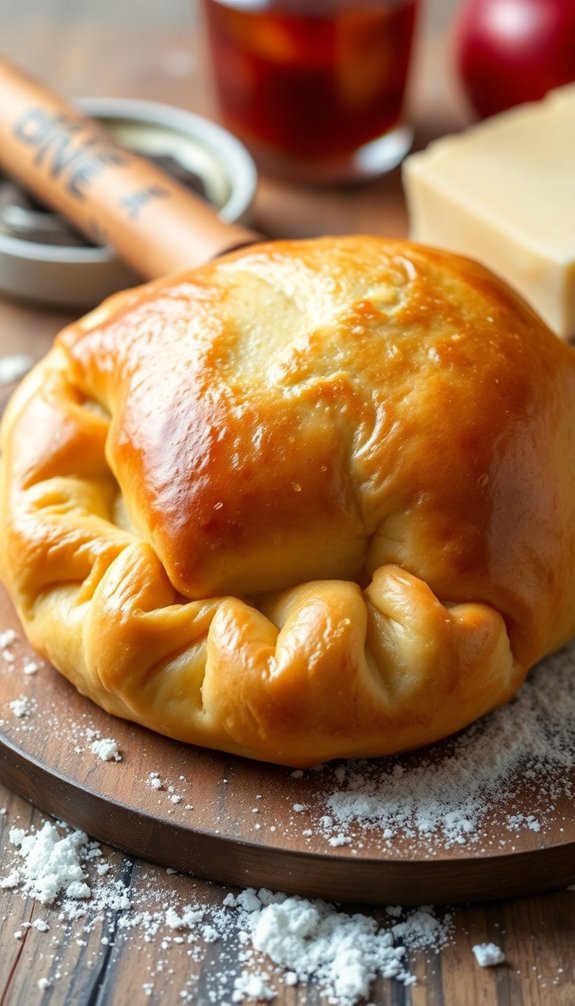
Getting the dough right is essential for making delicious kolaches. Start by activating your yeast in warm milk mixed with sugar until it's foamy. This step is vital for a light and fluffy texture.
Next, combine 3.5 to 4 cups of flour with 1/4 cup of melted butter for richness. Knead the dough on a floured surface for 10-15 minutes to develop gluten, which gives the dough its elasticity.
After mixing, let the dough rise in a warm place for about 1-2 hours until it doubles in size. Once it's risen, shape it into dough rounds, fill them, and let rise again before baking.
This second rise is key for achieving that perfect puff in your kolaches.
## Tips for Successful Baking
After you've mastered the dough preparation techniques, focusing on the baking process will help guarantee your kolaches turn out perfectly. Here are some key tips to keep in mind:
- Always check the expiration date on your yeast for peak freshness.
- Use warm milk (100°F to 110°F) to activate the yeast with sugar, ensuring it becomes foamy.
- Allow the dough to rise in a warm, draft-free area until it doubles in size.
Knead your dough for 10-15 minutes to develop gluten, which is essential for structure and elasticity.
After filling your kolaches, let them rise for an additional 15 minutes before placing them on a baking sheet.
Bake in a preheated oven at 350°F to 390°F for a golden brown finish.
Nutritional Information
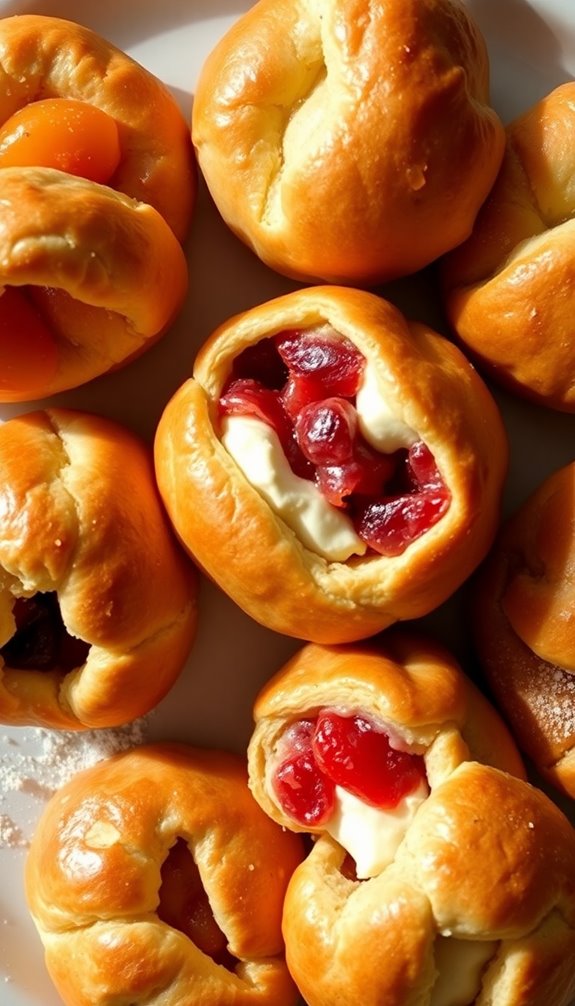
Understanding the nutritional information of kolaches can help you make informed choices while enjoying this delightful pastry. A typical kolache contains about 288 calories, 32 grams of carbohydrates, 7 grams of protein, and 15 grams of fat, including 9 grams of saturated fat.
The nutritional profile can vary considerably based on the filling. Fruit-filled kolaches offer essential vitamins and minerals, while savory options can provide more protein.
Keep in mind that kolaches made with whole milk, butter, and eggs contribute to their richness but also increase cholesterol content, averaging around 84 mg per serving.
For a balanced diet, consider choosing healthier fillings, like fruit or low-fat cheese, allowing you to savor this treat in moderation.
Kolaches vs. Donuts
When comparing kolaches and donuts, you'll find distinct differences in texture, flavor, and nutritional value that cater to various tastes and occasions.
- Kolaches are baked pastries with sweet yeast dough.
- Donuts are typically fried and often glazed with sugar.
- Kolaches often feature wholesome fillings like fruit preserves or cheeses.
Culturally, kolaches hold significance in Czech communities, often served during family gatherings, while donuts are more of a breakfast staple.
Nutritionally, kolaches tend to be less indulgent with lower sugar content, offering balanced options with potential for fruit or protein fillings.
In contrast, donuts usually pack in more calories and sugar due to their frying process and toppings.
Ultimately, both pastries have their own unique appeal!
Community and Kolache Culture
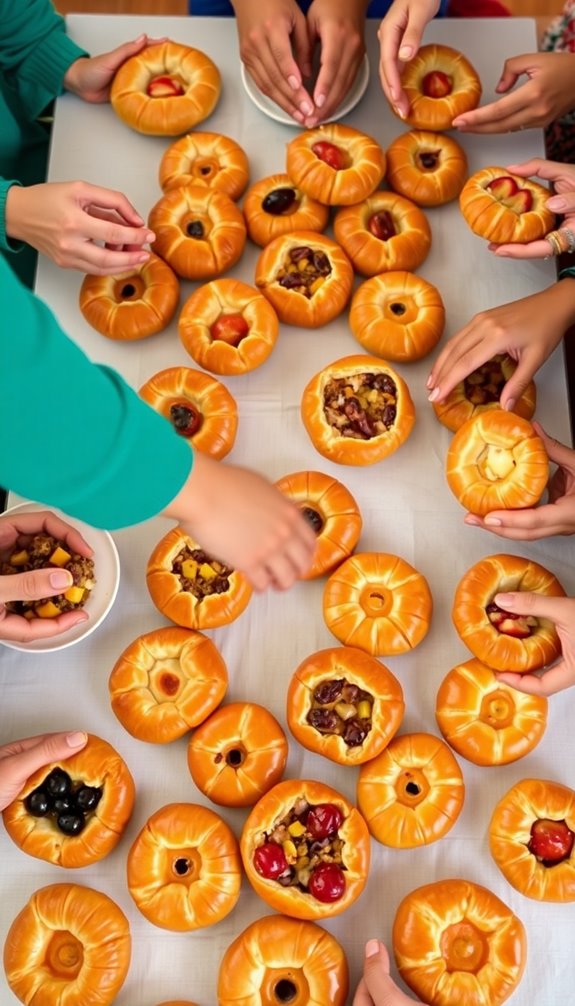
Kolaches are more than just delicious pastries; they serve as a cultural symbol within Czech communities, especially in Texas.
You'll find these beloved treats at family gatherings, strengthening connections and preserving traditions. Annual events, like the Burleson County Kolache Festival, draw crowds that celebrate kolaches as an essential part of Czech-American identity.
Local bakeries host pop-up events, featuring both traditional and creative flavors, fostering community engagement and supporting small businesses.
Baking contests at heritage events allow Czech families to share treasured recipes passed down through generations, reinforcing their culinary legacy.
As kolaches gain popularity outside Texas, they continue to unite people, showcasing the rich cultural significance and pride of the Czech community.
Conclusion
In wrapping up your kolache journey, it's clear these delightful pastries hold a special place in culinary culture. With roots tracing back to Bohemia, they've evolved into a beloved treat, especially in Texas. Whether you're savoring sweet or savory fillings, there's a kolache for every palate. So, gather your ingredients and channel your inner pastry chef—these little puffs of joy are worth every effort. After all, who wouldn't want a taste of history baked into their day?


